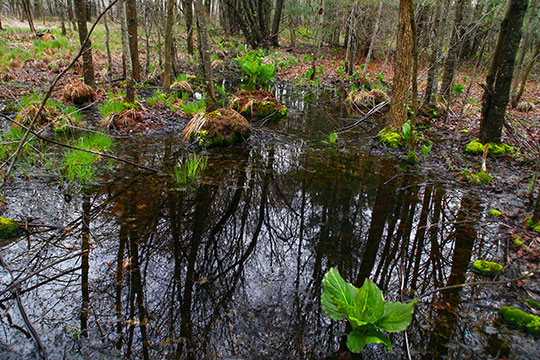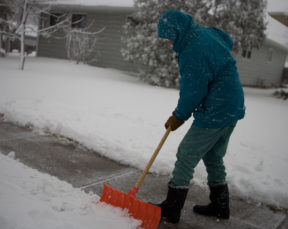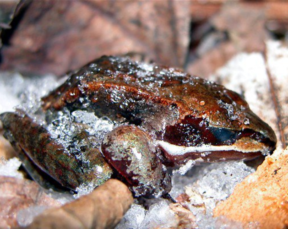I mean a vernal pool —- not a swimming pool (the man-made, permanent, in-ground facility, where the water source is human, not just from nature). Even if you do not have a vernal pool of your own, we need to appreciate the value they bring to us.
Vernal pools are seasonal wetlands created from local surface water runoff. They are covered by shallow water for variable periods from winter to spring, but may be completely dry for most of the summer and fall. The N.J. Div. of Fish and Wildlife estimates that 3,000 — 5,000 vernal pools occur annually in New Jersey.
These wetlands range in size from small puddles to shallow lakes, and usually are found on a gently sloping plain of grassland. Vernal pools can form anywhere that a depression fills with water. Beneath vernal pools lie either bedrock or a hard clay layer in the soil that helps keep water in the pool. Typically, the pools collect water during winter and spring rains, changing in volume in response to varying weather patterns. During a single season, pools may fill and dry several times, but by definition they must hold water for two consecutive months. In years of drought, some pools may not fill at all.
Why are vernal pools important? Appearances may be deceiving. The unique environment of vernal pools provides habitat for numerous rare plants and animals that are able to survive and thrive in these conditions. Many of these plants and animals spend the dry season as seeds, eggs. or cysts, and then grow and reproduce when the pools are again filled with water. In addition, birds such as egrets, ducks and hawks use vernal pools as a seasonal source of food and water. The amphibians associated with vernal pools also provide an important food source for small carnivores, as well as large game species.
Normally, a vernal pool will be devoid of fish, which permits the safe development of natal amphibians and insect species unable otherwise to withstand their competition from, or their consumption by fish.
Many of the amphibians that breed only in vernal pools spend most of their lives in the uplands within hundreds of feet from the vernal pool. Eggs are laid in the vernal pool, then the juveniles leave the pool two or three months later, not to return until the following spring to breed. Therefore, the upland areas surrounding a vernal pool are critical for the survival of these species.
The most obvious inhabitants of vernal pools are various species of breeding frogs and toads. Some salamanders also use vernal pools for reproduction, but the adults may visit the pool only briefly. Other notable inhabitants are fairy shrimp, the wood frog, the bullfrog, the Eastern spadefoot toad, and some species of mole salamanders. Reptiles, like turtles and snakes, even baby rattlesnakes, will pray upon crustaceans and other pool invertebrates. They eat the eggs and larvae of amphibians. Deer and raccoons will also use vernal pools for food and drinking water.
Sometimes being out at a vernal pool at night is a very noisy experience. Like a high-pitched guitar (only better), hundreds of Spring Peepers (a variety of very small frog) will be trying to find love, while creating a deafening chorus. They make their call while semi-submerged in the water.
By late spring or early summer, many young salamanders and frogs will have undergone metamorphosis and left the pond for the forest or fields, to continue their life cycle. The large number of organisms using vernal pools each year shows how essential these pools are to the life cycles of forest species.
Vernal pools also support some unique flowering plants that make a brief above-ground appearance when the weather begins to warm. In the spring, wildflowers often bloom in brilliant circles of color that follow the receding shoreline of the pools. But like the pools that spur them, they are short-lived. After blooming and setting seed they lose their foliage, storing gained energy in their roots to wait for the next year. As the water has evaporated, the clay pools will once again appear brown, barren and cracked.
New Jersey legislation seems to have done little to protect vernal pools. In this state, wetlands smaller than one acre are exempt from regulatory protection, and most vernal pools in New Jersey are less than 0.25 acres, says the N.J. Division of Fish and Wildlife. Therefore, many New Jersey vernal pools can be filled, drained or modified without a general permit.
Vernal pools are a valuable and increasingly threatened ecosystem, often smaller than the bulldozer that threatens to destroy them. Great efforts are being made to protect the remaining vernal pools, as their disappearance marks the loss of rare and important habitat and some of the associated plant and animal species as well. Vernal pools are often threatened by residential and commercial development in the same way that other wetlands are. As a result, many pools have been converted into residential zones, roads and industrial parks. Therefore, many of the surviving vernal pools continue to survive only because they are on protected land, such as national parks and other government-owned property, or on the private land of conservation-minded owners.





how can I protect my vernal pool from neighbors phragmite stance?